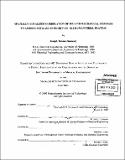| dc.contributor.advisor | W. Eric L. Grimson. | en_US |
| dc.contributor.author | Samosky, Joseph T. (Joseph Thomas) | en_US |
| dc.contributor.other | Harvard University--MIT Division of Health Sciences and Technology. | en_US |
| dc.date.accessioned | 2006-02-02T18:48:40Z | |
| dc.date.available | 2006-02-02T18:48:40Z | |
| dc.date.copyright | 2002 | en_US |
| dc.date.issued | 2002 | en_US |
| dc.identifier.uri | http://hdl.handle.net/1721.1/31105 | |
| dc.description | Thesis (Ph.D.)--Harvard--Massachusetts Institute of Technology Division of Health Sciences and Technology, 2002. | en_US |
| dc.description | Includes bibliographical references (p. 216-225). | en_US |
| dc.description.abstract | Osteoarthritis is a painful degenerative joint disease affecting millions of people in the U.S. The pathogenesis of articular cartilage disease is characterized by softening of cartilage and loss and disruption of constituent macromolecules including proteoglycans and collagen. In current orthopaedic surgical practice, the gold standard for evaluating articular cartilage integrity is the use of a hand probe during arthroscopy. Mechanical probing, however, is invasive and requires anesthesia. Tightly confined areas of the articular surface can be difficult to reach and assess, and manual probing provides a subjective rather than a quantitative assessment of cartilage mechanical integrity. This thesis was motivated by the desire for a noninvasive and nondestructive means to map the variation in mechanical stiffness of an articular surface. Such a method could potentially have application to guiding surgeons during procedures and quantitatively assessing the efficacy of medical and surgical therapies. It could also potentially provide patient-specific, in vivo tissue mechanical property data for surgical simulation and preoperative procedure planning. The macromolecule glycosaminoglycan (GAG) is a significant determinant of cartilage stiffness. GAG content can be assessed noninvasively in vivo and in vitro by an MRI-based technique known as delayed gadolinium-enhanced magnetic resonance imaging of cartilage (dGEMRIC), which measures the MRI parameter TI after equilibration with the ionic contrast agent Gd(DTPA)2-. With dGEMRIC, TlGd serves as an index of GAG content: we therefore examined whether cartilage stiffness could be related to dGEMRIC-measured TlGd in samples of human tibial plateaus. | en_US |
| dc.description.abstract | (cont.) We developed an experimental methodology to permit indentation test sites and regions in dGEMRIC scans to be registered with submillimeter accuracy. We found that the load response to focal indentation (a measure of local stiffness) and locally-averaged TlGd were in general highly correlated (Pearson correlation coefficients r = .80, .90, .64, .81 (p < .002) for four different patient samples, 130 total test locations). We further demonstrated that the observed correlation is not a simple consequence of cartilage thickness effects. We observed that the parameters of the stiffness-TIGd relationship differed in some samples between the region of the tibial plateau covered by the meniscus in vivo and the more central region normally in contact with the femoral condyle. This suggests that another factor such as surface architecture or collagen integrity also influences the indentation response of the articular surface. | en_US |
| dc.description.statementofresponsibility | by Joseph Thomas Samosky. | en_US |
| dc.format.extent | 225 p. | en_US |
| dc.format.extent | 14916245 bytes | |
| dc.format.extent | 14945682 bytes | |
| dc.format.mimetype | application/pdf | |
| dc.format.mimetype | application/pdf | |
| dc.language.iso | eng | en_US |
| dc.publisher | Massachusetts Institute of Technology | en_US |
| dc.rights | M.I.T. theses are protected by copyright. They may be viewed from this source for any purpose, but reproduction or distribution in any format is prohibited without written permission. See provided URL for inquiries about permission. | en_US |
| dc.rights.uri | http://dspace.mit.edu/handle/1721.1/7582 | |
| dc.subject | Harvard University--MIT Division of Health Sciences and Technology. | en_US |
| dc.title | Spatially-localized correlation of MRI and mechanical stiffness to assess cartilage integrity in the human tibial plateau | en_US |
| dc.type | Thesis | en_US |
| dc.description.degree | Ph.D. | en_US |
| dc.contributor.department | Harvard University--MIT Division of Health Sciences and Technology | |
| dc.identifier.oclc | 50658050 | en_US |
